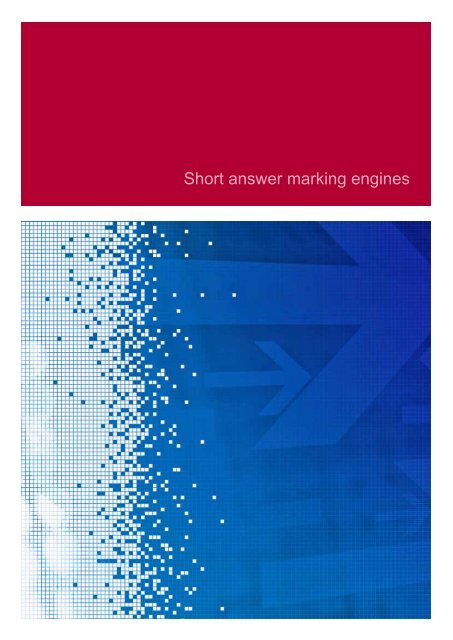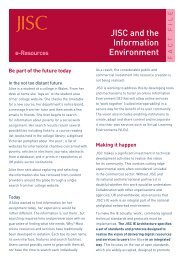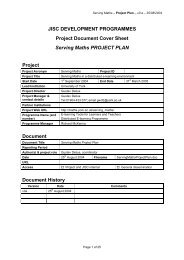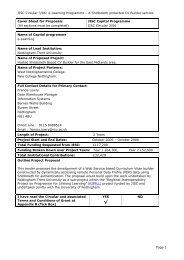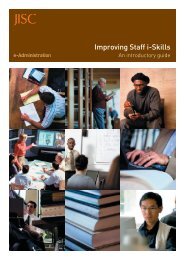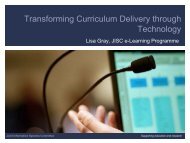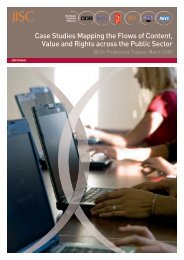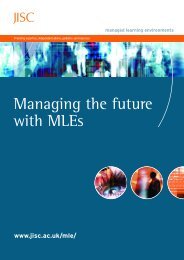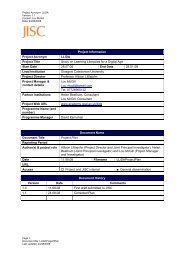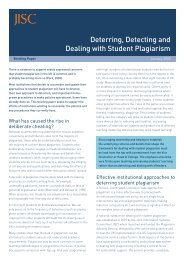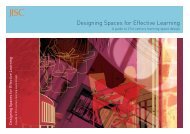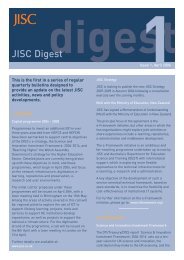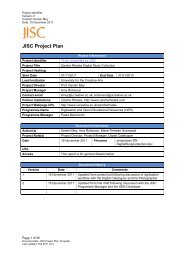Case Study - Short Answer Marking Engines - Jisc
Case Study - Short Answer Marking Engines - Jisc
Case Study - Short Answer Marking Engines - Jisc
You also want an ePaper? Increase the reach of your titles
YUMPU automatically turns print PDFs into web optimized ePapers that Google loves.
<strong>Short</strong> answer marking engines
<strong>Short</strong> answer marking engines<br />
What are short answers?<br />
“<strong>Short</strong> answers” implies free text entry, requiring answers<br />
that have to be constructed rather than selected, ranging<br />
from phrases to (rarely) 3 to 4 sentences. In the context of<br />
e‐assessment, “short text marking” is an abbreviation of the<br />
phrase “automated marking of short free text responses to test<br />
items”. Candidates making a “free text response” are required to<br />
provide an answer to a test item in their own words as opposed<br />
to making a choice from a list of possible answers. There is<br />
no absolute definition of “short” but it is usually taken to mean<br />
that the marking algorithm can attempt a syntactic analysis<br />
of the response followed by some form of semantic analysis,<br />
something that is beyond the state of the art above 20 words<br />
or so.<br />
Why use short answers in assessments?<br />
Question types that marking engines are<br />
good at marking<br />
<strong>Short</strong> answer marking engines work best with questions<br />
producing convergent answers, that is, where there are a limited<br />
(though large) set of answers that the examiner is looking for,<br />
where knowledge and understanding is being tested, and where<br />
content is important rather than style.<br />
http://://www.iaea2008.cambridgeassessment.org.uk/ca/<br />
digitalAssets/164792_Siddiqi_Harrison.pdf. This might be<br />
seen as a limitation but most summative and much formative<br />
assessment is aimed at finding out what the student knows<br />
or can deduce. Questions leading to divergent answers are<br />
generally seeking to explore the quality of thought of the student<br />
and, as such, are not well marked by the marking engines (and<br />
indeed, do not generally elicit consistent marks from human<br />
assessors).<br />
Multiple choice items (in all their variety) are a very efficient<br />
means of assessment, particularly though not exclusively, at<br />
lower taxonomic levels (eg knowledge, understanding and<br />
recall). Their ability to be fully computerised in delivery, marking<br />
and analysis make them popular and their use is especially<br />
associated with educational testing in the United States. Good<br />
multiple choice items are, however, notoriously hard to construct<br />
and have been criticised because they test the candidate’s<br />
ability to select an answer rather than to freely construct one.<br />
<strong>Short</strong> answer questions demanding short (free) text responses<br />
can be more testing in that candidates have to create their own<br />
response rather than choosing amongst plausible alternatives.<br />
An assessment regime should use a variety of question types<br />
and modes of response if it is going to adequately test a<br />
candidate's performance and short text marking engines can<br />
increase this variety as they allow the inclusion of short answer<br />
questions which can also be effectively computerised.<br />
The testing of ability to construct a sustained argument, which<br />
is often tested in essay questions, is not well-addressed through<br />
short text assessment. The best-known program for marking<br />
essays is ETS 1 e-rater (ETS) which compares correlates of<br />
essay quality (eg style, vocabulary, length) with those of a<br />
battery of pre-graded scripts, finds the best match and scores<br />
accordingly. It is admirably suited to a tradition where scripts<br />
are routinely doubly marked by examiners but is not used as a<br />
lone marking system. There is no sense in which the program<br />
‘understands’ the content of the essay.<br />
Questions that marking engines find it hard<br />
to mark<br />
<strong>Short</strong> text marking engines do not cope well with questions<br />
where there is an unpredictable range of acceptable answers,<br />
eg “What is democracy?” or where the answer is complex eg<br />
“Was Churchill a good prime minister and why?” Where marking<br />
engines have difficulty with scoring an item, closer moderation<br />
of the item will often reveal ambiguities or infelicities which<br />
can be corrected. Used routinely, this moderation process can<br />
suggest improvements to assessment and teaching.<br />
1 Education Testing Services, based in Princeton and elsewhere<br />
1
Feedback<br />
<strong>Short</strong> answer marking engines can be used for assessments<br />
which are being used formatively, summatively or intended<br />
to achieve both outcomes. Used formatively, not only can the<br />
software provide an instant mark but it can also give answerspecific<br />
feedback. Several attempts at answering a question<br />
can be allowed (and recorded) and being a part of the learning<br />
process, cheating is pointless. Used summatively, the provision<br />
of feedback may be more problematic (but see the Open<br />
University case study below).<br />
Common characteristics of how the marking<br />
engines work<br />
Widely used short text marking engines include:<br />
• C-rater (Educational Testing Services)<br />
• systems developed by Jana Sukkarieh and Stephen Pulman<br />
at Oxford (later continued at Cambridge Assessment) and<br />
• the marking engine and authoring tool developed by<br />
Intelligent Assessment Technologies (IAT).<br />
These have all been developed over some years and offer<br />
HEIs the opportunity to replace or augment their e-assessment<br />
systems at relatively low cost.<br />
The systems have been developed independently but<br />
show marked convergence in how they work. All perform a<br />
limited analysis of student responses using broadly similar<br />
computational linguistics techniques. They follow the same<br />
basic pattern.<br />
1. examiner generates top-level marking guideline – what the<br />
examiner is looking for<br />
2. a small set of model answers (variously called ‘templates’,<br />
‘canonical representations’ or ‘patterns’) is produced and<br />
developed using sample responses<br />
3. student responses are analysed to see whether they are<br />
credit-worthy paraphrases of the model answers<br />
4. there is a moderation process where the scoring is checked<br />
There is generally human intervention at 1, 2 and 4 but,<br />
increasingly, tools are provided to make the generation of<br />
templates and moderation more straightforward and efficient.<br />
There are differences between (and within) systems as to how<br />
much of the pattern matching is done by the machine and how<br />
much by a human and for any set of results, there is (as one<br />
might expect) a trade off between the complexity of the answers,<br />
the amount of human input and the accuracy of the final scores.<br />
Pattern-matching can be set to be strict or lax, generating higher<br />
proportions of false negatives or false positives respectively, and<br />
systems can run with more or less human intervention.<br />
Fully automated machine learning approaches have been<br />
attempted (eg see Sukkarieh, J. Z. and Pulman, S. G. (2005)).<br />
Comparing the student response with the model answer<br />
Expert<br />
Normalise<br />
syntax<br />
Normalise<br />
morphology<br />
Student<br />
<strong>Answer</strong><br />
Contextualised<br />
spell-checker<br />
Resolve<br />
pronouns<br />
Identify<br />
synonyms<br />
Model<br />
of correct<br />
answer<br />
Mapping<br />
Canonical<br />
representation<br />
(templates)<br />
Links<br />
Leacock, C and Chodorov, M. (2003). C-rater: Automated Scoring of short answer Questions. Computers and<br />
Humanities, 37, 4, 389-405. Also http://www.ets.org/Media/Research/pdf/erater_examens_leacock.pdf<br />
Sukkarieh,J. Z. , Pulman, S. G. and Raikes, N. (2003) Auto-marking: using computational linguistics to score short free<br />
text responses. http://www.clg.ox.ac.uk/pulman/pdfpapers/AUTOMARKING2.htm<br />
Pulman, S. & Sukkarieh, J. (2005) Automatic <strong>Short</strong> <strong>Answer</strong> <strong>Marking</strong>. Proceedings of the 2nd Workshop on Building<br />
Educational Applications Using NLP, Ann Arbor, June 2005. http://www.comlab.oxford.ac.uk/people/publications/<br />
date/Stephen.Pulman.html<br />
http://www.intelligentassessment.com<br />
The specific model illustrated is C-rater. The expert is helped to produce model answers through the use of an application called<br />
Alchemist through which the expert stipulates what essential points are required in order to gain credit and identify likely synonyms.<br />
Students' responses are used to train the system (with human intervention).<br />
1 spell-check Program is forewarned of likely words and will preferentially correct to these. It cannot, however, correct<br />
misspellings which have resulted in a different English word eg ‘umber’.<br />
2 normalizing syntax Program identifies verb, subject and object and reconfigures as ordered list (tuple)<br />
3 morphology Endings (inflections) are removed eg subtracts, subtracting, subtraction are all reduced to subtract.<br />
Negative prefixes are also stripped out and replaced with ‘not’ viz ‘is unfair’ to ‘is not fair’.<br />
4 pronoun resolution Program identifies all the noun phrases that precede the pronoun and selects the one that the pronoun is<br />
most likely to refer to.<br />
5 synonyms Synonyms are generated automatically from a dictionary but synonyms are preferred which match the<br />
context of the rest of the answer.<br />
There is a comparative study at http://www.iaea2008.cambridgeassessment.org.uk/ca/ digitalAssets/164792_<br />
Siddiqi_Harrison.pdf<br />
2<br />
3
The process in practice<br />
Intelligent Assessment Technology’s system is used as an<br />
exemplar.<br />
1. The examiner writes the item, possibly using an authoring<br />
tool or other preferred software.<br />
2. The paper-based mark scheme, and any sample responses<br />
if available, are used to create computerised mark scheme<br />
files using the authoring tool. The templates may be tested<br />
against more sample answers. This process will often reveal<br />
improvements that can be made to questions. The items and<br />
their markschemes are collated into a test.<br />
3. Mark schemes are uploaded to the server running the<br />
marking engine via web services.<br />
4. The test is delivered to students (see diagram below).<br />
5. Student responses are marked using the computerised mark<br />
schemes previously uploaded.<br />
6. Optionally, a sample of the student responses may used to<br />
moderate the computerised mark schemes for some items.<br />
This is mostly required when new items are being used<br />
for the first time. After moderation, responses may be remarked<br />
using the moderated mark schemes<br />
7. Results are output.<br />
Human markers mark sample responses against the mark scheme to provide training data for the system<br />
during mark scheme authoring.<br />
Paper mark<br />
scheme<br />
Mark scheme<br />
authoring tool<br />
Sample<br />
responses<br />
Computer<br />
mark scheme<br />
Authoring the mark scheme in the authoring tool involves an iterative process of adding and modifying model<br />
answers, testing the marking at each iteration.<br />
Students take<br />
web-based test<br />
Student<br />
responses<br />
MARKING<br />
ENGINE<br />
Marked<br />
responses<br />
F E E D B A C K<br />
Results<br />
Moderation<br />
tool<br />
The main mark scheme authoring interface.<br />
4<br />
5
Other marking systems<br />
There are also simplified approaches that use a “bag of words”<br />
approach and string matching. These can be effective if the<br />
teaching context is well-known and consistent restricting the<br />
range of likely answers, if the length of answer allowed is<br />
restricted and proficient staff are available. It is quite feasible<br />
to dispense with the syntactical analysis and simply use string<br />
matching of keywords to identify correct and incorrect answers<br />
if these rather narrow conditions are met. More sophisticated<br />
techniques (though still not employing computational linguistics)<br />
such as the OU’s PMatch can be used where series of rules are<br />
developed by inspection to act as a correct-answer sieve.<br />
Where next<br />
It is tempting to assume that the marking engines will get more<br />
and more sophisticated until they can mark paragraphs of text<br />
for meaning but this is unlikely in the foreseeable future. The<br />
computer systems do not ‘understand’ the content; they merely<br />
check whether the response is a paraphrase of one of the<br />
templates linked to the model answer. When human markers<br />
mark for meaning, they are comparing what the student says to<br />
an internalised world view. As Tom Mitchell says, ‘Computers<br />
have no world view.’ The marking engines are ingenious<br />
but they are not smart. As the amount of text to be marked<br />
increases so does the range of possible responses and the<br />
complexity of the marking operation.<br />
Where the skill of weaving content into a sustained argument is<br />
required, this will continue to be assessed by human markers,<br />
even though achieving high inter-rater reliability is problematic.<br />
However, much can be computerised if it is permissible to<br />
structure the questions into sub-questions that can be assessed<br />
through short text answers..<br />
Where progress will be made is in the improvement to tools for<br />
the generation of the (automatic) mark schemes and the facility<br />
with which answers can be clustered for human intervention ie<br />
increased user-friendliness. While the use of short text marking<br />
engines still demands appreciable input and enthusiasm from<br />
the human assessor, implying up-front resource costs, the<br />
pay off can be considerable – a bank of moderated questions<br />
that mark themselves. Indeed, the effort required to create<br />
and moderate a mark scheme may be less, in one cycle, than<br />
that required to mark by hand. Moreover, academic end-users<br />
are rewarded by a greater understanding of the strengths and<br />
weaknesses of the questions they have set, the strengths and<br />
weaknesses of their students and the effectiveness or otherwise<br />
of the instruction.<br />
Benefit<br />
Too often e-assessment is perceived as being coincident<br />
with multiple choice testing. The general advantages of<br />
e-assessment (viz speed of marking, accuracy & consistency,<br />
reduction in marking drudgery, practice for student through<br />
repetition, reduced costs, better assessment data collection<br />
leading to better feedback) can be extended to other, more<br />
natural forms of assessment.<br />
<strong>Short</strong> answer marking engines offer automatic assessment<br />
of constructed answers which may be better than selected<br />
response or other closed items at exploring candidates’<br />
knowledge and understanding and thus encourage deeper<br />
learning. With more effort, answer-specific feedback can be<br />
provided in real time (see OU below).<br />
If a teacher uses questions just once for a single class, there<br />
is no point in spending time generating an automatic marking<br />
model. But if the questions are used for several classes over<br />
several terms the initial effort may be repaid. As the usage<br />
increases so does the time saving. The discipline of generating<br />
questions that the marking engine unambiguously marks may<br />
be valuable for the teacher/assessor.<br />
Furthermore, moderation provides useful insight for the teacher/<br />
assessor into how students actually answer questions – e.g.<br />
what their misunderstandings/miscomprehensions are and<br />
thereby feedback into teaching and the curriculum. This is a<br />
useful side effect of being able to see all student responses for<br />
each question listed on a screen.<br />
Open University (OU): short answer free text<br />
questions in online interactive assessment<br />
contact details<br />
Sally Jordan S.E.Jordan@open.ac.uk<br />
Philip Butcher P.G.Butcher@open.ac.uk<br />
The Centre for Open Learning of Mathematics, Computing,<br />
Science and Technology (COLMSCT)<br />
The Open University<br />
Walton Hall<br />
Milton Keynes<br />
MK7 6AA<br />
http://www.open.ac.uk/colmsct/<br />
Brief details<br />
A small number of short answer questions are included<br />
in progress tests which are used both summatively and<br />
formatively. There are nine tests throughout the year<br />
contributing 20% of overall marks in a 60 credit 1st year<br />
undergraduate distance-learning science course (S104). Other<br />
items are either selected response (eg multi-choice, drag<br />
and drop etc) or type in single word/number answer. Students<br />
are given three attempts at each question with an increasing<br />
amount of instantaneous feedback. This enables them to learn<br />
from the feedback by acting upon it immediately.<br />
What was the problem?<br />
The adult students of the UK Open University study at a<br />
distance, usually with the support of part-time tutors who,<br />
amongst other things, offer comments and grading on tutormarked<br />
assignments (TMAs). TMAs have always been regarded<br />
as having an important teaching as well as assessment function.<br />
E-assessment provides the opportunity to deliver feedback<br />
to students instantaneously and to free up tutor time to offer<br />
support to students in other ways.<br />
The Open University Science Faculty has been using<br />
e-assessment for a number of years. The three qualities sought<br />
in the feedback on e-assessment tasks are:<br />
• it should be instant<br />
• it should be meaningful, ie sufficiently detailed to allow the<br />
student to move on<br />
• it should be contextualised, ie relevant to the mistake made.<br />
The team developing S104 Exploring Science wanted to use<br />
regular interactive computer-marked assignments (iCMAs)<br />
in addition to TMAs in order to develop understanding and<br />
increase student motivation. S104 is a nine-month course that<br />
is presented twice each year, with around 1600 students per<br />
presentation.<br />
A 20% summative weighting (continuous assessment) was<br />
agreed with the university as a compromise between the benefit<br />
of encouraging students to engage with the tests and the<br />
perceived danger of plagiarism (because correct answers are<br />
provided as part of the formative feedback).<br />
The S104 course team wanted to test recall as well as<br />
recognition (of the right answer) and also wanted to test<br />
students’ understanding and reasoning ability. A spread of<br />
question types was used to achieve this.<br />
S104 is a science course containing several disciplines. It was<br />
thought that, whilst physics might be adequately assessed with<br />
closed questions demanding one word or numerical answers,<br />
other disciplines eg biology and Earth sciences, would require<br />
more discursive answers. In the event, the physicists also took<br />
advantage of the opportunity to ask more searching questions<br />
demanding a less predictable short text answer.<br />
In order to mark the short answer free-text responses, the<br />
Open University chose to integrate a natural language based<br />
assessment engine module from Intelligent Assessment<br />
Technologies (IAT) within their own OpenMark system.<br />
http://www.open.ac.ukopenmarkerexamples/index.shtml<br />
How does the solution work?<br />
The project was funded jointly by the Open University VLE<br />
Project and the Centre for Open Learning of Mathematics,<br />
Science, Computing and Technology (COLMSCT), as one of<br />
a number of practitioner-led projects researching innovative<br />
uses of e-assessment in the interactive computer-marked<br />
assessment initiative.<br />
The tests are authored, delivered and marked using The Open<br />
University’s OpenMark CAA system, an open source system<br />
which includes the capacity to deal with constructed responses.<br />
This uses mainly xml plus a programming language (Java) for<br />
more sophisticated question types and operations. When the<br />
Open University decided to adopt Moodle (also open source)<br />
as the base system for their VLE, OpenMark iCMAs were<br />
integrated within Moodle as an alternative to iCMAs written<br />
entirely as Moodle quizzes (the Open University is the global<br />
maintainer of the Moodle quiz engine).<br />
OpenMark provides the university with additional functionality<br />
but the appearance and behaviour of tests provided through<br />
each system is now quite similar. The IAT add-on allows<br />
additional functionality through the marking of short text items<br />
The systems have tended to converge so that it is difficult to<br />
tell whether items have been authored using Moodle or in<br />
OpenMark (where specialists perform any necessary Java<br />
programming)<br />
6<br />
7
Because of the problem of plagiarism, many questions are<br />
populated with variables ensuring that students get a randomly<br />
generated parallel question. This is easy to do in a programming<br />
language like java but hard in xml.<br />
In each S104 iCMA, the student is presented with ten items (and<br />
can review them all before attempting any). A correct answer<br />
elicits a mark and a model answer. A first incorrect response<br />
usually elicits a general hint (perhaps as simple as “try again”).<br />
A second incorrect answer elicits a context specific response,<br />
encouraging the student to rethink their approach to the<br />
question. A typical iCMA might include around two questions<br />
requiring free-text answers of around a sentence in length. The<br />
answer matching for these questions is currently written by a<br />
member of the course team, using the IAT authoring tool, and<br />
each student response is sent from the OpenMark server to an<br />
IAT server in order to verify whether it is a correct and to trigger<br />
appropriate instantaneous feedback.<br />
‘Try again’<br />
Context<br />
specific<br />
help<br />
‘Incorrect’<br />
+ model answer<br />
Incorrect answer<br />
Incorrect answer<br />
Incorrect answer<br />
Question<br />
author<br />
Candidate<br />
navigates<br />
test<br />
Item<br />
First attempt<br />
Second attempt<br />
Third attempt<br />
Response<br />
bank<br />
M O D E R A T I O N<br />
Question<br />
bank<br />
OpenMark<br />
test<br />
engine<br />
Correct answer<br />
‘Well done’<br />
+ model answer<br />
IAT<br />
mark schemes<br />
IAT<br />
marking engine<br />
Preliminary evaluation indicates that students are highly appreciative of the instantaneous feedback they receive. A student who has<br />
recently completed S104 commented, “I thoroughly enjoyed the course especially the interactive DVDs and found the iCMAs a<br />
very useful tool for checking that I had understood each topic.”<br />
Feedback to<br />
candidate<br />
Results<br />
8<br />
9
Partial credit<br />
Partial credit is awarded when a student gets a question correct<br />
after receiving feedback and at their second or third attempt.<br />
Student scores are transferred to the Moodle Gradebook and<br />
thence to the student and their tutor.<br />
Moderation<br />
The OU prides itself in having brought the system into operation<br />
with the maximum number of answers being correctly marked<br />
automatically. For open-ended questions, this demands<br />
considerable input at the moderation stage when marking<br />
schemes are being developed. Reliability in excess of that<br />
achieved through normal human marking is routinely achieved.<br />
Benefits<br />
The system works best with questions whose correct answers<br />
are fairly predictable. But the OU have purposely been trying<br />
to push the system as far as possible and still achieve high<br />
reliability. Once trained, the computer marking is generally<br />
more consistent than human markers. Questions the computer<br />
finds difficult to mark are often ones that human beings also<br />
find difficult to mark consistently – eg where the argument is<br />
confused or contradictory. This can bring benefits, see below.<br />
The high throughput of students and reuse of questions<br />
makes the time spent on generating computer mark schemes<br />
worthwhile. In a purely summative system, the reuse of<br />
questions might prove problematic given that the system<br />
provides correct answers but as their use is predominantly<br />
formative, the student is encouraged to work through the test in<br />
the way intended and thus generate useful summative scores<br />
as well. Clearly this would be impossible in any paper–based<br />
system. Responses from students indicate that the feedback<br />
appears to motivate students on the course to apply themselves<br />
to their learning.<br />
Over time, the system encourages students to express<br />
themselves clearly and succinctly, revealing (and honing) their<br />
true understanding. Similarly, the moderation process reveals<br />
to tutors not only where students have misconceptions but<br />
also mistakes in question framing or indeed mistakes in course<br />
material.<br />
Future<br />
OpenMark and Moodle iCMAs are being used for diagnostic,<br />
formative and summative assessment in an increasing number<br />
of situations. Questions using the IAT system are now in use on<br />
three courses and members of other course teams have been<br />
trained in the use of the IAT authoring tool.<br />
Links and references<br />
For a description of the use of Moodle/OpenMark etc.: Butcher, P. (2008). Online assessment at the Open University<br />
using open source software: Moodle, OpenMark and more. 12th International CAA Conference, Loughborough, UK.<br />
www.caaconferences.com/pastConferences/2008/proceedings/index.asp<br />
For background on the development of e-assessment at the OU (OpenMark etc):<br />
Ross, S.M., Jordan, S.E & Butcher, P.G. (2006). Online instantaneous and targeted feedback for remote learners. In C.<br />
Bryan & K.V. Clegg, K.V. (Eds), Innovative assessment in higher education (pp. 123–131). London: Routledge.<br />
For the current project:<br />
Jordan, Sally and Mitchell, Tom (2009) E-assessment for learning? The potential of short free-text questions with<br />
tailored feedback. British Journal of Educational Technology, 40, 2, pp. 371-385<br />
10<br />
11
Dundee Medical School<br />
contact details<br />
Professor John McEwen j.mcewen@dundee.ac.uk<br />
Walter Williamson w.m.williamson@dundee.ac.uk<br />
University of Dundee Faculty of Medicine, Dentistry and<br />
Nursing<br />
Ninewells Hospital<br />
Dundee<br />
Scotland<br />
DD1 9SY<br />
Outcome<br />
Clinical skills<br />
Practical procedures<br />
Investigations<br />
Patient management<br />
What a doctor<br />
is able to do<br />
The progress test contains questions dealing with all aspects<br />
of the course. Thus first year students have to anticipate the<br />
correct answers to much of the material and graduating students<br />
need to recall knowledge that was formally introduced years<br />
before. As all questions are free text entry, there is far less<br />
problem with correcting for guessing. At the end of Year Five,<br />
students are assessed on the basis of a portfolio of evidence<br />
but, before computerisation, it proved impossible to mark the<br />
progress test in time for the results to be included. There is<br />
no formal pass mark; students are expected to demonstrate<br />
mastery of the content of the course.<br />
The answers of the Year Five cohort are used to moderate the<br />
marking scheme which is then applied to the later assessments<br />
of other year groups. In the early years, paper-based responses<br />
were available to the questions.<br />
Brief details<br />
Health promotion<br />
Dundee have produced a fully computerised 270 item progress<br />
Communication skills<br />
test, assessing students’ basic core knowledge (recall), the<br />
essential knowledge required to be a Pre Registration House<br />
Officer (PRHO). All items are short answer and marked<br />
automatically. All students in years 1-5 sit the same test in<br />
any academic year. On average, each year there is a 20%<br />
replacement of items.<br />
What was the problem?<br />
Information handling<br />
Basic knowledge<br />
Attitude, ethics, legal<br />
Reasoning, judgement<br />
How a doctor<br />
approaches<br />
their practice<br />
Set up<br />
<strong>Marking</strong> guidelines are developed as described above,<br />
high level guidelines are established and then templates<br />
developed. At Dundee there is no pre-trialling of questions,<br />
year 5 answers are used to moderate the templates. Just as<br />
moderation was necessary when the test was administered<br />
on paper, so it is in the computerised version but moderating<br />
tools make the process quicker and more efficient<br />
It was suggested to Dundee by the General Medical Council<br />
(GMC) review team that an additional test of essential<br />
knowledge be added to the range of assessments employed<br />
by Dundee to check the achievements of student outcomes,<br />
to provide student feedback and monitor the effectiveness of<br />
the teaching. This would provide teachers and students with a<br />
sense of how they were progressing relative to their previous<br />
performance and to their peers. The use of selected response<br />
(ie MCQs) was rejected on the grounds that future doctors<br />
would need to determine not select courses of action and<br />
that therefore answers should be recalled not recognised. A<br />
progress test was designed by the team with the assistance of<br />
Professor M. Friedman on secondment from a US university and<br />
was piloted on paper in 2001 and 2002.<br />
http://www.ncbi.nlm.nih.gov/pubmed/10353288<br />
The test was well-liked, reliable and valid but there was a<br />
prohibitive workload of marking and moderating in order to<br />
provide feedback to the students in years 1-4 and to inform<br />
the final assessment in year 5. The decision was then taken to<br />
computerise the test.<br />
how does the solution work?<br />
Questions are distributed amongst subject areas in proportion<br />
to the amount of curriculum time devoted to them, tagged<br />
according to which of the twelve outcomes they assess.<br />
Role of doctor<br />
Personal development<br />
The doctor<br />
as a<br />
professional<br />
These twelve outcomes permeate all five years of the course. In<br />
addition, there are three phases of instruction progressing from<br />
the theoretical to the practical.<br />
F I V E Y E A R S<br />
Phase one: structure and function<br />
in health<br />
Phase two: structure and function<br />
in illness<br />
Phase three: management of core clinical<br />
problems<br />
Delivery<br />
Computer<br />
marking<br />
Computer<br />
assisted<br />
moderation<br />
Output<br />
results<br />
Students log into a secure account on a locked down university<br />
machine. Questions are displayed eight per screen and the<br />
order is randomised to safeguard against overlooking by other<br />
students. Students have the opportunity to edit their answers.<br />
There is a time limit of 3 hours.<br />
Using the templates developed in the set up, the tests are<br />
marked automatically<br />
Selected questions (eg new ones) are moderated. Moderation<br />
can take place on screen by human markers. Markers log<br />
in via a browser and select the test they wish to moderate.<br />
Responses are grouped according to their similarity to aspects<br />
of the marking guideline.<br />
12<br />
13
Selecting which question to moderate. The system provides simple item statistics, and marking confidence indicators from the freetext<br />
marking engine.<br />
Moderating a question. The top three responses were flagged by the computerised marking process as possible marking errors<br />
(indicated by the red icon in the ‘Flag’ column).<br />
14<br />
15
The experience of computer moderation<br />
Benefits<br />
Moderation is performed by a group of experts who review the<br />
answers to each item together rather than separately, as is<br />
necessary on paper. Some corrections are made to computer<br />
marking but generally the process reveals problems with the<br />
marking guidelines or the item itself. Feedback is available to<br />
item writers to help them improve future items.<br />
Accuracy<br />
During the delivery of the initial computerised test, 5.8% of<br />
computer marks had to be changed at moderation. However, the<br />
majority of these were due to shortcomings in the original paper<br />
guidelines (which would also have to have been corrected in a<br />
human marking regime). Only 1.6% were due to errors on the<br />
computer marking template. After these faults were corrected ,<br />
the system delivered a match between computer marking and<br />
moderated human marking of 99.4%. An analysis of human<br />
marking at Dundee revealed between 5 and 5.5% marking<br />
errors compared to 5.8% for unmoderated computer marking<br />
and around 1% for moderated computer marking.<br />
Developments<br />
Computerising delivery has avoided the printing of 800 copies<br />
(in multiple versions) of the 30 page test, items are merely<br />
uploaded onto the test database. Moderation is quicker and<br />
more efficient on screen as responses can be grouped and<br />
prioritised. <strong>Marking</strong> templates can be moderated using a subset<br />
of the cohort. Amended schemes can then be applied to the<br />
rest of the cohort automatically. This dramatically saves work<br />
and speeds up the marking procedures – results can now be<br />
generated in time to feed to the end of course assessment<br />
process. Years 1–4 can be marked automatically without the<br />
need for further moderation, scored immediately and the results<br />
fed back to the students.<br />
Students now have access to reliable assessments of their<br />
mastery of the twelve outcome areas and can check that they<br />
are progressing as they should. Similarly, staff can easily<br />
review students’ retention and the effectiveness of teaching. In<br />
2005, the teaching model was changed and analysis of the test<br />
results, tagged as they are against different outcomes and year<br />
of instruction, allowed the effects of the change to be monitored.<br />
Transfer students are now routinely given the progress test to<br />
determine their level of knowledge.<br />
Much of the generation of marking templates and corrections to<br />
those templates in the light of moderation has been performed<br />
by IAT computer staff ie outside the Medical school. From 2009,<br />
the new authoring tool provided by IAT will obviate this, allowing<br />
the medical school to update its item bank without external<br />
support.<br />
16
<strong>Short</strong> answer marking engines


